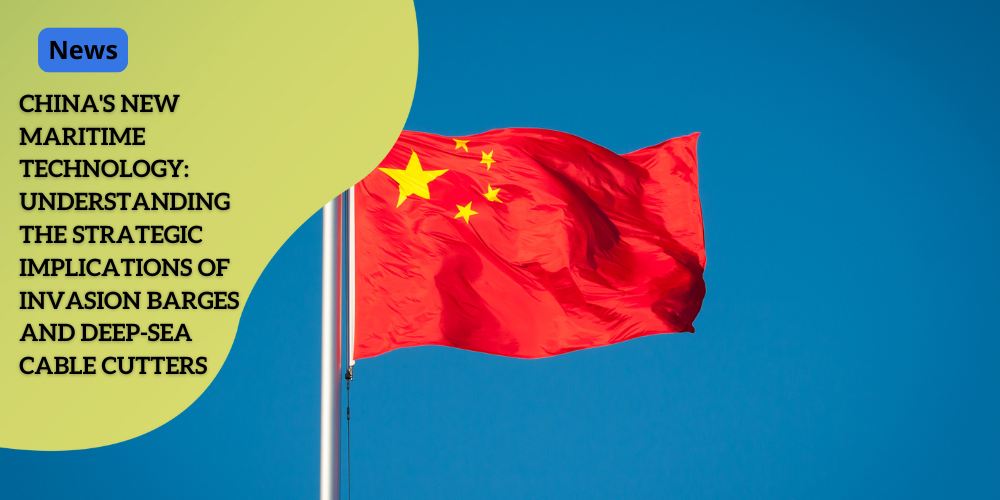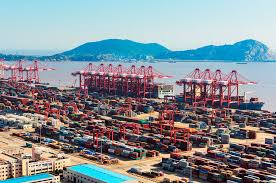China’s New Maritime Technology: Understanding the Strategic Implications of Invasion Barges and Deep-Sea Cable Cutters

 Introduction: China’s Maritime Technology Advancements
Introduction: China’s Maritime Technology Advancements
China’s recent advancements in maritime technology have captured global attention, particularly the development of massive invasion barges 
These innovations are unfolding amid heightened tensions between China and Taiwan, sparking concerns about their potential military applications and implications for regional security.

 Military Invasion Barges: A Technical and Strategic Marvel
Military Invasion Barges: A Technical and Strategic Marvel
One of the most significant technological breakthroughs is the introduction of invasion barges, a system of massive linked barges extending 800 meters from shore.
These barges possess the capability to function as relocatable piers, enabling the rapid deployment of military vehicles and equipment 
This technological marvel provides a strategic advantage in amphibious operations by creating makeshift landing points for an invasion force.
The barges’ ability to support large quantities of tanks and armored vehicles greatly enhances China’s amphibious assault capabilities, proving crucial in hypothetical invasion scenarios such as that of Taiwan.
 Deep-Sea Cable Cutting Technology: Disrupting Communication
Deep-Sea Cable Cutting Technology: Disrupting Communication
Equally alarming is China’s development of advanced deep-sea cable cutters capable of operating at unprecedented depths of up to 4,000 meters.
These devices are designed to sever undersea communication and power cables, posing a potential threat to Taiwan’s infrastructure 
The implications are profound, as these cutters could disrupt military communications between Taiwan and its allies, particularly the United States 
This capability could compromise the island’s defense posture and contribute to the broader strategy of isolation and destabilization.
 Dual-Use Technology Concerns
Dual-Use Technology Concerns
| Aspect | Civilian Use  |
Military Potential |
|---|---|---|
| Disaster Relief | Assists in emergency response and rebuilding efforts | Enables rapid deployment of military forces |
| Undersea Cables | Maintains and repairs global communication networks | Disrupts enemy communication during conflicts |
| Military Modernization | Technological progress for peaceful advancements | Strengthens strategic military positioning |
| Geopolitical Impact | Supports global infrastructure development | Raises concerns over China’s ambitions in Taiwan |
 Context of Rising Tensions
Context of Rising Tensions
These technological developments come at a time of escalating tensions between China and Taiwan 
The ruling Communist Party of China (CPC) views Taiwan as part of its territory and has not ruled out the use of force to achieve reunification.
Frequent military drills and incursions into Taiwan’s air defense identification zone are clear indicators of this pressure campaign.
Furthermore, China’s expanding technological capabilities align with President Xi Jinping’s declared goal of creating a “world-class” military by 2027, stoking fears of an imminent conflict within this timeframe.
 Future Strategic Implications
Future Strategic Implications
As we delve into the strategic implications of these technologies, it is essential to understand their role within China’s grander military modernization framework.
These advancements not only enhance China’s ability to project power but also reflect its readiness to leverage innovative solutions to achieve geopolitical objectives.
While the specifics of these military technologies will be further explored, it is crucial to recognize the broader context in which they are developing.
The strategic alignment between technological advancements and military objectives underscores the urgency of international attention and response
 The Revolutionary Invasion Barges
The Revolutionary Invasion Barges
 Technical Description of Linked Barges System
Technical Description of Linked Barges System
China’s recent development in maritime technology has led to the creation of massive linked barges, which can extend up to 800 meters from the shore.
These barges work together to form a remarkable system, standing on sturdy legs above the water and connected by bridges, resulting in a giant causeway structure 
This setup is designed to be flexible and relocatable, capable of transforming into makeshift piers as needed.
The substantial length and versatility of these barges make them useful for both military and civilian purposes, but the primary concern is their potential military application.
 Rapid Deployment Capabilities
Rapid Deployment Capabilities
One of the most significant aspects of these barges is their ability to function as relocatable piers. They can support the quick deployment of military vehicles and equipment, including tanks and armored vehicles.
In the context of a possible invasion, such as an attack on Taiwan, these barges could be deployed rapidly to aid in amphibious operations.
They provide a stable platform in shallow waters, where traditional piers might not be available or reliable.
The strategic innovation here lies in their ability to deliver a high volume of vehicles and heavy equipment in a short amount of time.
Defense analyst J. Michael Dahm highlights that these barges could potentially offload hundreds of vehicles per hour onto a remote beach, a damaged port, or any austere landing area, assuming fire superiority has been established.
 Strategic Military Applications
Strategic Military Applications
The innovative design of these barges offers China a significant strategic advantage in potential amphibious operations.
The barges are not only useful as landing platforms but could also play a role in establishing temporary coastal landing points.
This capability could be crucial if Taiwan were to destroy its ports in an attempt to thwart an invasion.
The barges, with their extendable ramps and stable platforms, can effectively create new access points for troops and equipment 
Moreover, these barges enhance operational speed.
They have been observed to be set up, broken down, and set up again multiple times within days. This reusable and mobile nature allows for fast adjustments and redeployments according to strategic needs.
However, they remain vulnerable to enemy fire due to their slow speed and size, meaning they would likely be deployed only after securing air, naval, and informational superiority.
With these capabilities integrated into their military strategy, China solidifies its potential for swift and efficient amphibious assaults and logistics support.
As part of a broader military modernization effort, these barges represent a leap forward in China’s ability to project power and respond rapidly during military engagements.
 Deep-Sea Cable Cutting Technology
Deep-Sea Cable Cutting Technology
China’s recent strides in developing deep-sea cable cutters have left geopolitical analysts on edge.
These devices, tailored to operate at remarkable depths of 4,000 meters, are seen as both engineering marvels and potential tools for military advantage.
The ability to sever undersea cables, which form the backbone of global communication and internet connectivity, signals a shift in maritime power dynamics.
Yet, the implications for Taiwan, situated in a politically sensitive region and heavily reliant on these cables for both civilian communication and military coordination, are particularly concerning.
 Technological Development
Technological Development
This deep-sea cable cutter represents a significant leap in maritime engineering.
Traditionally used for maintenance purposes, cable-cutting tools are being scrutinized for their potential role in undermining Taiwan’s infrastructure.
The strategic value lies in the ability to disrupt vital communication lines, effectively plunging an adversary into immediate turmoil by cutting off its link to essential services.
The Chinese advancements suggest an evolved capability not just to maintain but to strategically disable this critical network, posing a dual-use threat—benign in peacetime but potentially devastating during conflict.
 Strategic Threats to Taiwan
Strategic Threats to Taiwan
Taiwan, a democratic island nation that China considers a breakaway province, is particularly vulnerable.
With undersea cables constituting the primary channel for internet and telecommunications for the island, disruption could lead to a severe communications blackout.
This, in turn, could create chaos and confusion among the public and military alike.
More concerningly, in a hypothetical conflict scenario, cutting these cables could stagger Taiwan’s defensive capabilities, impairing its ability to coordinate with allies like the United States 
In a world where information is synonymous with power, such an offensive capability could serve as a pivotal element of psychological and strategic warfare.
 Broader Implications
Broader Implications
The emergence of these advanced cable cutters ties into a broader story about China’s military ambitions.
As part of its goal to modernize the People’s Liberation Army and achieve a ‘world-class’ standing by 2027, these developments underline a systematic upgrading of capabilities.
Such advancements raise the stakes for regional security, urging nations to recalibrate their defense postures in anticipation of new forms of warfare.
Military and political leaders worldwide are now compelled to examine how this technology might alter current security frameworks.

China’s recent maritime technological advancements, notably the invasion barges and deep-sea cable cutters, play critical roles in potential Taiwan invasion scenarios, raising the alarm among global defense observers.
 New Role in Hypothetical Invasion Scenarios
New Role in Hypothetical Invasion Scenarios
The massive invasion barges, capable of forming floating piers, provide China with the ability to swiftly deploy substantial military assets across coastal waters.
In a potential invasion of Taiwan, these barges could be pivotal in offloading tanks and heavy machinery onto shorelines, bypassing traditional ports.
Their potential to create temporary coastal landing points enhances China’s capacity to conduct amphibious operations.
Meanwhile, the deep-sea cable cutters could further undermine Taiwan’s defense by severing critical undersea communication lines, creating a communication void that would severely hamper coordination with allies.
 Integration within China’s Military Modernization
Integration within China’s Military Modernization
These technological leaps are not standalone efforts but are seamlessly integrated with China’s broader military modernization initiative.
The invasion barges and cable cutters represent a fraction of the advanced platforms, weapon systems, and munitions tested by the People’s Liberation Army (PLA).
This comprehensive modernization strategy aligns with China’s ambition to cultivate a “world-class” military force by 2027 under Xi Jinping’s directive.
 Aligning with Xi Jinping’s Military Goals
Aligning with Xi Jinping’s Military Goals
The overarching goal of these military enhancements is clear—readiness to act under Xi Jinping’s orders if and when a strategic advantage presents itself.
With expectations set for 2027, these preparations underscore Xi’s commitment to challenging Taiwan’s autonomy through assertive military postures.
The PLA’s capacity to leverage these technologies effectively translates Xi’s vision into a tangible threat, consolidating China’s power in the region.
While China’s maritime advancements have captured significant attention, they also provoke reactions from international and regional powers.
The implications of these technologies extend beyond military preparedness, nudging other global powers to reassess their defense strategies.
The conversation now pivots towards how these developments provoke international response and elevate security concerns.

As China’s maritime technology advancements continue, the international community, especially defense experts, has taken notice.
The development of invasion barges and deep-sea cable cutters has significant implications for global security, sparking concerns and prompting responses from various quarters.
 Expert Analysis of China’s Military Capabilities
Expert Analysis of China’s Military Capabilities
Defense experts argue that these technologies could be instrumental in boosting China’s amphibious assault capabilities.
The rapid deployment speed of the invasion barges and the threat posed by the cable cutters to undersea communications raise alarms about their use in potential conflicts, particularly a Taiwan invasion.
 Taiwan’s Defensive Preparations
Taiwan’s Defensive Preparations
In response to these developments, Taiwan has been ramping up its defensive preparations, including evaluating measures to protect undersea cables and enhance its amphibious counter-strategies.
 Regional Security and International Relations
Regional Security and International Relations
China’s advancements align with President Xi Jinping’s ambition to create a “world-class” military by 2027, escalating global security concerns. As a result, many nations are strengthening alliances and military cooperation to counterbalance China’s growing influence.
The implications of China’s maritime technologies are vast, reshaping geopolitical tensions and requiring a coordinated international response.
Furthermore, China’s advancements align with President Xi Jinping’s ambitious goal of modernizing the PLA and creating a “world-class” military by 2027.
This objective has escalated the sense of urgency among the international community, prompting discussions about strengthening alliances and enhancing military cooperation to counterbalance China’s growing influence.
The geopolitical landscape is being reshaped, with increased defense spending and military readiness becoming a priority for many nations in response to China’s expanding capabilities.
While the international community continues to assess and respond to these developments, it is clear that China’s maritime technology poses significant strategic challenges.
Addressing these concerns will require a coordinated effort from all involved parties regional allies and global powers alike. In the near future, the emphasis will probably continue to be on ensuring regional stability and preventing conflicts through diplomatic and military measures.






